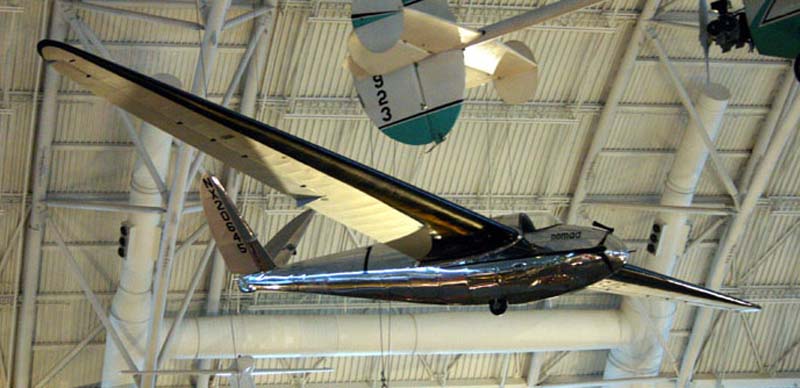| Stanley | |||
 |
|||
|
|||
|
Stanley Nomad Robert M. Stanley completed the Nomad in June 1938 in San Diego, California, during a stint in the U. S. Navy. He wrote down general specifications for the sailplane in 1935, and continued to refine the design while serving aboard the USS Ranger. Stanley finished building the Nomad in the basement and yard of a house he shared with other Navy personnel. With no previous experience flying sailplanes, Stanley first flew the Nomad at the 1938 National Soaring Contest at Elmira, New York. After he landed in a field at the end of a cross-country flight, a souvenir hunter stole the elevator control surfaces. Stanley replaced the conventional tail with one of the first V-tails seen on an aircraft. Stanley returned to Elmira in 1939 and he flew the Nomad to a new American altitude record, 4,987 m (16,400 ft), that more than doubled the old record. The next day, July 4, Stanley broke the record again, climbing to 5,254 m (17,284 ft) inside a towering thundercloud. Stanley became president of the Soaring Society of America in 1940, but he did not design and build another sailplane. He worked for the Bell Aircraft Corporation as that firm's chief test pilot during the war, and he made the first flight in America's first jet aircraft, the Bell XP-59 (see NASM collection). Dimensions: Wingspan: 17.4 m (57 ft) Length: 6.6. m (21 ft 7 in) Height: 1.7 m (5 ft 6 in) Weights: Empty, 164 kg (360 lb) Gross, 250 kg (550 lb)
Source:
Smithsonian National Air & Space Museum |
|||
|
Stanley Aviation Robert M. Stanley (August 19, 1912 - July 16, 1977) was an American test pilot and engineer. He became the first American to fly a jet aircraft on October 2, 1942, as a civilian test pilot for Bell Aircraft. He flew the Bell XP-59A Airacomet, which was the United States' first turbojet aircraft. The flight took place at Muroc Dry Lake, California. The Airacomet is on display at the National Air & Space Museum in Washington, DC. Other Achievements
Stanley was tragically lost July 16, 1977, flying with two of his sons, along with the wife of one son and fiance of the other, and lifelong friend, Darwin Phillip Lowry of Overland Park, Kansas, in the crash of the Stanley company's Aero Commander. The plane encountered a severe wind shear on approach to the Ft Lauderdale, FL, International Airport, as the family was returning from a vacation trip to the Caribbean and broke up in flight. Source: Wikipedia |
